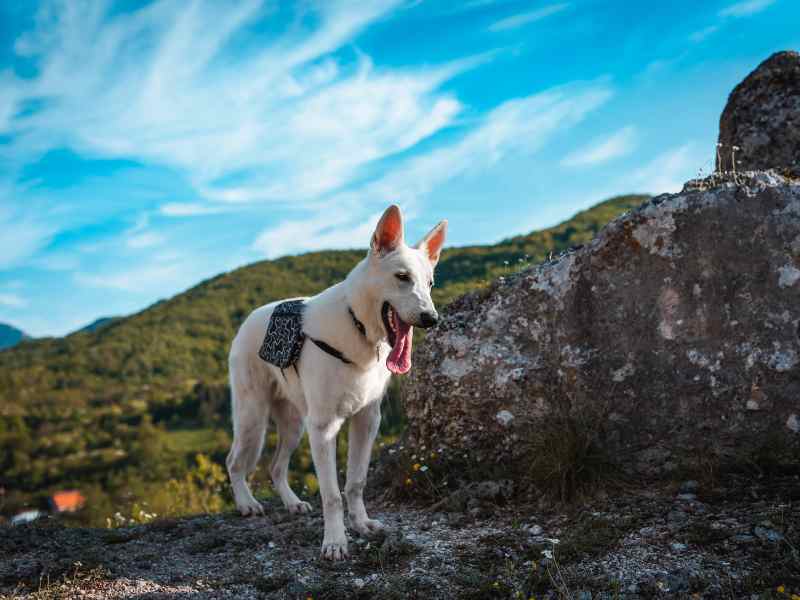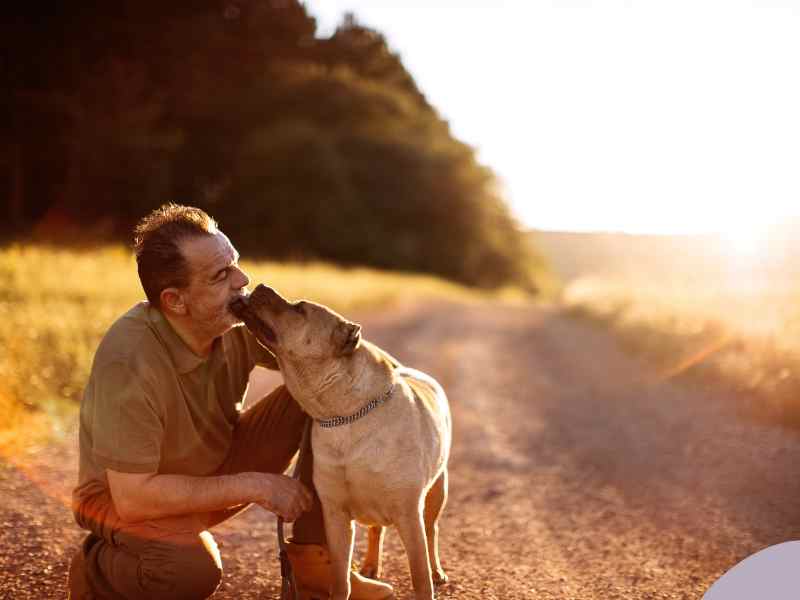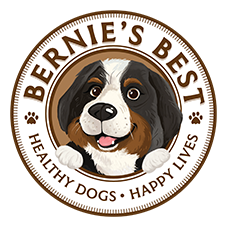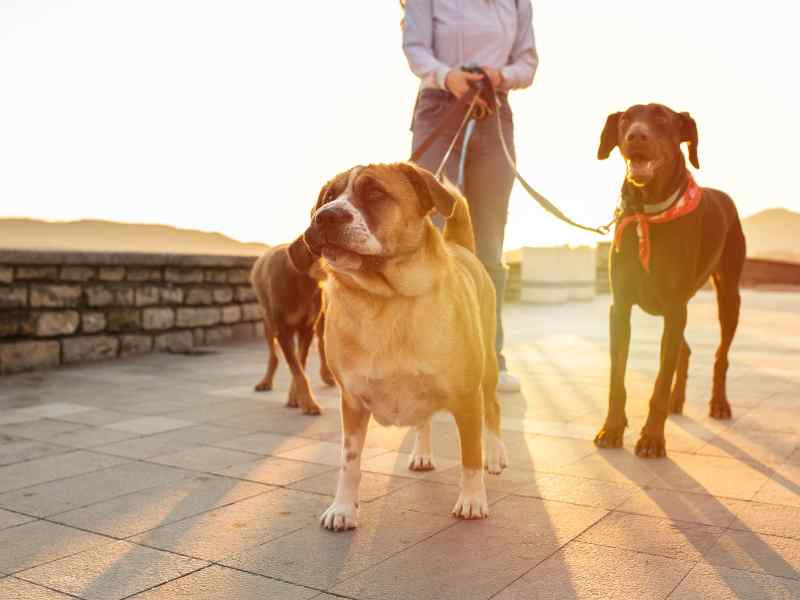Initiated by FitPaws in 2017, April is Canine Fitness Month. This month is a great time to focus on the important role of physical activity for your dog in helping maintain their health and happiness. Through activities ranging from simple walks to complex agility training, Canine Fitness Month encourages dog owners to explore new ways to stay active with their pets, which is a win for them and for you!
The Importance of Keeping Dogs Fit and Healthy
The concept of fitness for dogs goes beyond just their physical well-being; it also includes mental health and the strength of the bond between dogs and their owners. Regular physical activity is pivotal for managing weight, improving cardiovascular health, and reducing the risk of chronic diseases. Additionally, engaging in exercise with your dog can alleviate anxiety and stress, contributing to a happier and more content pet, and that makes for a happier and more content you!
National Canine Fitness Month Activities
FitPaws suggests several activities to celebrate Canine Fitness Month, including:
- Longer and More Frequent Walks: Aim for walks of 45 minutes or more to provide substantial exercise. Even 30 minutes can significantly benefit your dog’s fitness.
- Active Play: Utilizing balls, sticks, or frisbees can encourage your dog to move more while having fun.
- Indoor Gym: When outdoor conditions are unfavorable, creating an indoor gym with activities that improve strength, balance, cardio, flexibility, and mental fitness can be an excellent way to keep your dog active.
- Exercise Together: Including your dog in your home workouts can be a fun way to ensure you both get the exercise you need.
The Importance of Fitness for Dogs: A Scientific Perspective
Keeping dogs in tip-top shape isn’t just something vets talk about – it makes a real difference in their daily lives and ours! From staying trim to keeping their ticker ticking properly, regular play and exercise can help dodge some pretty serious health bullets like diabetes and heart trouble. But, it’s all about finding that sweet spot of activity that fits their breed and age. A sprint for a Great Dane may be a week’s worth of marathons for a Yorkie. Finding the right fit for you and them means consistency, and that’s really what brings about fitness.
And, it’s not just about their bodies. Their minds get a huge fitness boost too! A game of fetch can do wonders for a dog’s mood and help them shake off boredom or depression. That means it may keep bad habits at bay – a busy dog is usually a happy dog, after all. Keeping your dog fit is like hitting two birds with one stone: your dog gets their exercise, and their mental health gets a nice focus too.
The best part about spending time getting active with your dog, though, is that it strengthens your bond with them. Just picture it–the wind in your hair and your four-legged best friend by your side as you run, play, or tackle an agility course together. It’s not just a great picture or a fun experience; it builds trust and mutual respect. Helping keep them fit is building a friendship for life.
From a health standpoint, exercise improves a dog’s physical appearance and bone health and enhances organ and lung function. This comprehensive physical improvement makes dogs less prone to injury, brain ailments, and bone disorders, significantly contributing to their overall longevity and quality of life.
Mental Health Benefits Of Canine Fitness Month
Dogs that engage in regular physical activity have better muscle tone, are less likely to develop emotional problems, and display fewer behavioral quirks. Exercise gives them an effective outlet for getting rid of that restless energy, reducing nervousness when left alone, and reducing the prevalence of anxiety-induced behaviors. In fact, lots of vets will tell you that exercise is the number one way to combat anxiety in dogs.
But engaging in exercise activities together not only promotes their physical health of you both but also strengthens your emotional bond. Activities such as walking, running, playing fetch, or participating in dog sports like agility training or canicross (running or biking with your dog) offer opportunities for bonding, improving your dog’s behavior through structured and intentional interaction, and enhancing your happiness in the whole process. It’s really a win-win!
Assessing Your Dog’s Fitness Level
Understanding whether your dog is fit or needs a bit of help in getting into shape can be crucial for their overall health and longevity. Here’s how you can assess your dog’s fitness level and consider adjusting their fitness routine.
Signs of a Fit vs. Unfit Dog
Body Condition Score (BCS): A key indicator of a dog’s fitness is their Body Condition Score, which assesses fat to muscle ratio. Ideal scores on a nine-point scale are 4 or 5, indicating a healthy balance with a visible waist and ribs that are easily felt but not seen.
Physical Appearance and Behavior: Fit dogs have good muscle tone, are enthusiastic about exercise, and have a healthy appetite. Unfit dogs might display lethargy, have difficulty in breathing after mild exertion, show reluctance to exercise, or have an uneven distribution of fat (American Kennel Club).
Adjusting Fitness Routines
Age and Breed Considerations: Young puppies and large-breed dogs have different exercise needs compared to adult dogs. Puppies, for instance, benefit from short play sessions rather than prolonged exercise, while large breeds may be prone to joint issues, necessitating moderated activity levels.
Health Status: Dogs with health issues such as arthritis or obesity may require specific types of exercise to avoid exacerbating their conditions. Low-impact exercises like swimming can be beneficial for overweight dogs or those with joint problems.
Exercise Type and Duration: Start with gentle exercises and gradually increase intensity and duration based on your dog’s response. Regular walks are a great way to start, with the possibility of incorporating more vigorous activities like running or agility training as your dog’s fitness improves.
Fun and Effective Ways to Keep Your Dog Fit
Okay, so you want to work on some fitness activities with your dog–that’s great! Here are some of our favorites!
- Daily Walks and Hikes
Consistent daily walks or hikes keep your dog’s cardiovascular health in check and help manage their weight. Venturing into new territories or trails stimulates your dog’s mind, reducing boredom and destructive behavior. The varied terrain can also help improve their muscle tone and balance. - Playing Fetch and Frisbee
This activity combines the joy of play with vigorous exercise, improving your dog’s agility and coordination. Fetch and Frisbee are interactive games that keep both pet and parent active, fostering a stronger bond between the two.
- Agility Training
Agility courses challenge your dog’s mind and body, requiring them to think and move quickly through various obstacles. Agility training can be tailored to any fitness level, making it suitable for most dogs, and can be done in a class setting or at home with homemade or store-bought equipment.
- Swimming
Swimming provides a low-impact way to build muscle and improve cardiovascular health, which is ideal for dogs with arthritis or recovering from surgery. It’s also a great way to keep your dog cool and exercised during the hot summer months.
For dog owners who may not have easy access to large outdoor spaces or traditional dog sports facilities, there are plenty of innovative ways to ensure your pet stays active and healthy. Here are some out-of-the-box ideas:
- Indoor Obstacle Course
Use household items like chairs, blankets, and brooms to create an obstacle course inside your home. This can include tunnels to crawl through, hurdles to jump over, and slaloms to weave through. It’s a great way to keep your dog physically active and mentally stimulated without needing to leave the house.
- Stair Climbing
If you have stairs in your home, encourage your dog to climb up and down. You can make it a fun game by throwing a toy to the top and then calling them back down. Stair climbing is excellent for building leg strength and improving cardiovascular health.
- Tug of War
A simple tug-of-war game with a sturdy toy can provide both physical exercise and mental stimulation for your dog. Make sure, though, that it’s a controlled game where you teach your dog to start and stop on command to promote good behavior.
- Dance Party
Put on some music and dance around with your dog. Encourage them to jump, spin, and move along with you. Dancing can work out different muscle groups and is a fun way to bond with your pet while keeping both of you active. And they won’t care that you look silly!
- Hide and Seek with Treats
Hide treats around your house and let your dog find them. It’s a good way to engage their sense of smell and encourage physical activity. This game also stimulates their brain, making them think and work for their reward.
- Interactive Toys and Games
Invest in puzzle toys that require your dog to solve puzzles to get treats. These toys are designed to challenge their mind and keep them engaged for hours. Start with easier puzzles and gradually introduce more complex ones to keep your dog interested and mentally stimulated.
Importance of Downtime and Adequate Sleep
Dogs, much like humans, require sufficient rest for their bodies to repair and rebuild muscles after physical activity. This recovery period allows for a decrease in their cortisol levels and physiologic stress, which is what allows your dog’s body to fully relax and rejuvenate. Inadequate rest can lead to health issues and decreased performance in physical activities. On average, adult dogs need about 16 hours of rest/sleep every 24-hours, so they’re not just being lazy when they sleep all day!
Recognizing Signs of Overexertion In Your Dog’s Fitness Journey
Overexertion can manifest in various ways, including inflammation, soreness, and an overall decrease in physical performance. If your dog appears sore or tired after workouts, it’s a sign to allow for two to three days of rest before resuming any intense physical activities. Understanding your dog’s needs and abilities and observing changes in their behavior and physical state can help you adjust their activity levels to prevent overexertion.
Incorporating rest days into your dog’s routine is crucial. On these days, avoid overstimulating them physically and opt for activities that engage their mind instead, such as scent work games or puzzle toys. This approach helps achieve a healthy balance between physical and mental exercise, ensuring your dog remains fit without overexertion or stress.
The Role Of Nutrition And Hydration For Canine Fitness
For active dogs, nutrition and hydration are key components that support their high-energy lifestyle, promote muscle recovery, and maintain overall health. Here’s a breakdown of how to meet these needs:
Nutrition for Active Dogs During Canine Fitness Month
Active dogs require a diet that supports their increased energy needs while promoting muscle recovery and joint health. This means a diet higher in calories, with a focus on the right balance of fats, proteins, and carbohydrates.
Fats are a crucial energy source for active dogs, providing more than twice the energy of carbohydrates or proteins. They help by saving glycogen (which fuel energy) stores for longer periods of physical activity and are essential for the absorption of certain vitamins. Omega-3 and omega-6 fatty acids in fish oils are important for maintaining a healthy coat and skin.
Proteins are key for repairing and building muscle tissues. Dogs that engage in regular, strenuous activity require a higher protein intake to support muscle recovery and growth. Organ meats are particularly beneficial sources.
While normal dogs might not need a high intake of carbohydrates, active dogs may benefit from them as a source of quick energy. Grains and complex carbohydrates like sweet potatoes are recommended for their quick conversion to glucose, offering bursts of energy. Just remember it’s important to make sure that activity matches caloric intake.
Essential for overall health, vitamins and minerals support numerous bodily functions, including hormone regulation and nerve function. Vitamins A, D, and B-complex, along with minerals like sodium chloride, potassium, and magnesium, are particularly important for active dogs.
Hydration for Active Dogs During Canine Fitness Month
Hydration is critical for active dogs to prevent overheating and dehydration. They should have access to fresh water at all times, especially after a workout or fitness activity. Electrolytes lost through sweat can usually be replenished through a balanced diet, but in some cases, especially during prolonged activities or hot weather, you may need to supplement. It’s important to allow dogs to drink small amounts of water during activity so they don’t regurgitate or have gastric distress during the activity.
Supplements for Joint Health and Mobility
Active dogs, especially those engaging in high-impact activities, can benefit from supplements that support joint health and mobility. At Bernie’s Best, we understand that active dogs are not just pets; they’re companions, athletes, and family members who deserve a life free from the limitations and pains of joint discomfort and mobility issues. It’s hard to stay fit when you’re hurting, and we want to help dogs with that.
We’re inspired by cutting-edge research and the real-world needs of dogs because we create products for our own dogs first. We don’t use old-school ingredients like glucosamine and chondroitin, which, though well-known and popular, don’t really have the scientific backing that other ingredients out there do. Instead, we use innovative, scientifically supported ingredients that focus on getting to the nuts and bolts of joint mobility in dogs.
- Omega Fatty Acids: Sourced from flaxseed, anchovy, and algal oil, these support not just joint health, but also contribute to a healthy heart, brain function, and a lustrous coat.
- Antioxidants: Ingredients like astaxanthin and blueberries help protect the body from oxidative stress and free radicals, which can lead to various health issues.
- Anti-inflammatories: We include natural anti-inflammatories like turmeric/curcumin and green-lipped mussels to help manage inflammation and aid in recovery and movement.
- Undenatured Type II-C Collagen and Amino Acids: These are the building blocks of healthy tissues and are integral to maintaining strong, resilient joints.
- Vitamins and Minerals: Essential nutrients such as Vitamin K2 and Boron play a critical role in bone health and the body’s use of other minerals and vitamins.
We love our dogs and know you love yours. We want what’s best for them every day of the year, and not just Canine Fitness Month. Giving them Marvelous Mobility daily helps make sure theiry’re joints are in the best shape they can be all the time, and that means they’ll be up to whatever adventures you decide to take on!


